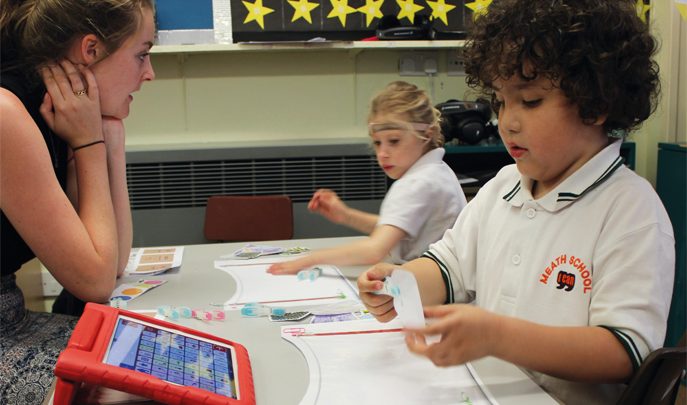Outstanding Special Schools – How a Therapeutic Programme and Finely Honed Teaching Approaches have Made an Impact at Meath Primary

"I think we have a certain responsibility to spread what we believe is best practice and what seems to work here."

- by Callum Fauser
- Editor of Teach Secondary magazine

Located in the village of Ottershaw, just outside Woking, Meath School has a very specific specialisation – primary age children with severe and complex speech, language and communication needs, including Asperger’s.
It’s one of two schools run by the children’s communication charity I CAN, the other being Dawn House in Nottingham with a predominantly secondary intake.
It doesn’t take long to notice the things that set Meath Primary apart from similar settings. We’re greeted upon arrival by Simon Elliott, the school’s head of therapy. As his job title suggests, speech and language therapy is central to life at the school.
Each of the six classes include a speech and language therapist among its typically three-strong teaching teams, alongside a class teacher and one or two learning support assistants. There’s even a small room attached to every classroom where the SLTs will conduct specific therapy programmes for individual pupils or small groups.
Elliott proceeds to give us a tour of the school, moving from the main administrative building, past the school’s 15-bed residential facility and across to a separate teaching building, through an entrance that opens out into the main hall where a literacy class is taking place.
We pass a small group of around five pupils, all following a teacher’s reading of a book while referring to a series of laminated visual supports.
Children at Meath are sorted into classes – Red, Blue, Purple, Orange, Yellow and Green – according to their comprehension levels, Red being the lowest and Green being the highest.
This means that age variation within the same class can be common (though typically not by more than a year), and that pupils can switch between classes throughout the year.
The first classroom we visit is that used by Red class, though the space actually consists of two separate classrooms adjacent to each other. This way, the full Red cohort of eight to 10 pupils can be taught more effectively in groups of two to four.
The day of our visit is something of a special one, however, as we walk in on a birthday party, complete with cake. It’s a celebration that warrants a larger than usual gathering of the class in one of the rooms, which helpfully shows the dynamics of the teacher/SLT/ LSA teaching team in action.
I watch as the team ably serve the children cake and keep them focused and engaged, while at the same time attending to those using their ‘Talkers’ – encased tablet devices loaded with custom AAC software.
Elliott explains that these are deployed with care in the classroom (multiple talkers going off at once making for something of a cacophony), but can also be lent out for families to use at home.
The party allows us to get a good look at the space in the unused classroom. Somewhat sparsely decorated, Simon tells me that the wall displays will be gradually added to over the coming year, a careful balance needing to be struck between providing helpful visual supports and not distracting the children’s attention.
All being well, however, these walls will soon be adorned with pictures that serve as a visual record of places the children have visited and things that they’ve achieved, reflecting their development from one month to the next.
From there, we move on to Green class, where a lesson on plurals is underway. It’s interesting to observe some of the key differences from what we’ve just seen.
Here, the class of 10 is taught together via a more traditional form of delivery, albeit one with notable distinctions.
For one thing, the teacher’s spoken instructions are accompanied by sign-supported English. Also, whenever a question is asked of a child, the teacher makes a point of first securing their full, undivided attention.
As headteacher Janet Dunn notes, ‘Once you’ve said a child’s name, you have to make eye contact in order to know that they’re processing. You can’t deliver instructions to their backs or the top of their heads, because they won’t process them.’
It’s also readily apparent how the questions themselves are very carefully pitched and interspersed with explanations that are divided into bite-sized chunks.
‘We have grades of questioning,’ explains Dunn, ‘the easiest being ‘What?’, ‘Who’and ‘Where?’ The hardest are ‘Why?’ and ‘How?’ It’s not related to age, but rather the children’s language development level.’
Of Meath’s general approach to classroom instruction, she adds, ‘Mainstream teachers will tend to give instructions in a clump – ‘First you must…then I want you to…and after that…and then…’
Our children will retain the first bit and the last bit and be able to recall them. What they can’t hold is the middle bit.’
Given the classification of the children at Meath School – ‘They’re able, but have special needs,’ as Dunn puts it – I ask how likely it is that similar children will be attending mainstream schools, and if so, how those schools might be able to identify them.
Dunn says, ‘We tell mainstream schools that if they have a child who appears very alert, gets really absorbed in experiential tasks and sometimes gives answers that seem surprising, then they may have language difficulties.’
Deputy head Pam Cosh picks up the point. ‘They can be very good and well behaved, but they’ll tend to be quiet and often watch what their friends are doing. If everyone’s standing and lined up, ready to go out and play, they’ll do that as well. Children are really good at hiding their difficulties, which can sometimes be hard to pick up on in a mainstream classroom.’
Meath Primary frequently receives visitors and regularly organises ‘professional visit days’, where representatives from other schools and organisations are able to sit in on classes and, for a fee, attend afternoon sessions where they can receive tailored support, advice and guidance from Meath’s leaders and practitioners.
One assumes that visiting SENCos and inclusion leaders are likely to find the facilities at Meath somewhat enviable – something not lost on Simon Elliott.
‘Not all mainstream schools will have the high staff-to-pupil ratio that we have, or the small classes,’ he concedes, ‘but there are certain things that we can advise, demonstrate and train on. I think we have a certain responsibility to spread what we believe is best practice and what seems to work here.’
Dunn sums up Meath’s core mission by describing ‘The joy of seeing the children in Red class, then watching them four or five years later in Green class. In Red they can barely attend for more than a five-minute span. Their sessions are all 15 to 20 minutes max. In Green class, you’ll see a 45-minute lesson with a proper classroom culture. That whole dynamic of a primary classroom is what we’re aiming for, because we want our children to be fit for secondary.’
Pupil voice
What do you like about school? Sean: The office ladies are nice. Georgina: I like to do work with the grown ups in my class. Sean: I like science and talking to my friends. Sunil: I like PE and reading, and break time, and football club.
What have you been doing in class today? Harry: Learning about time. Angela: Plurals. One cat; lots of cats. Kate: Times tables.
When you’re having problems in school, who helps you? Sunil: If I’m hurt I ask a buddy. Harry: I’m a buddy and like to wear my buddy hat. I walk around and pick the things up at the end of play. Angela: I like being a buddy, because I help all the children that are hurt or lonely. If they’re in a corner or something I’ll go up to them – ‘Are you alright?…’ Georgina: When little children are fighting I try to pull them away and stop them fighting, and tell whatever adult is in the playground.
Names have been changed
Meet the staff
Pam Cosh, Deputy head “We have quite rigorous whole school CPD which covers broad issues such as safeguarding, but can also cover more specific areas, such as the levels of questioning we use with the children. We’ll look at the type of questions that we ask of the children, and at how we can help them progress by asking better questions.”
Simon Elliott, head of therapy ‘Here, you really get to see the big picture. Yes, the children make progress in their speech and language skills, but you see them developing in all sorts of other ways as well – their confidence grows while they’re here. They develop friendships, where they might not have been able to do that previously.’










